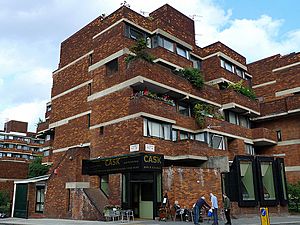Lillington Gardens facts for kids
Quick facts for kids Lillington Gardens |
|
|---|---|

A pub on the estate
|
|
| Status | Proposed |
| Construction | |
| Architect | Roger Westman, John Darbourne, Geoffrey Darke |
Lillington Gardens is a special place in Pimlico, a part of London, City of Westminster. It's a housing estate built between 1961 and 1971. The main architects who designed it were Roger Westman and the team of Darbourne & Darke. Today, CityWest Homes looks after the estate.
Contents
What Makes Lillington Gardens Special?
Lillington Gardens was one of the last big public housing projects built in London after World War II. It's known as one of the best designed.
A New Way to Build Homes
Before this estate was finished, many new homes were built in very tall tower blocks. But Lillington Gardens showed a different idea. It proved you could have many homes in one area without building super tall. It used medium-sized buildings instead.
This design was very clever. It focused on making each home feel unique. It also made sure people had their own private gardens. Some gardens were on the ground, and some were on the roofs of the buildings!
Blending In with History
The buildings at Lillington Gardens are very well made. The wide "roof streets" with their plants and gardens fit in perfectly. They look great next to the older Victorian buildings around them.
Awards and Recognition
The amazing design of Lillington Gardens has won many awards.
- In 1961, it received a Housing Design Award.
- In 1970, it won the Ministry of Housing and Local Government Award for Good Design.
- Also in 1970, it got an RIBA Award.
- In 1973, it earned an RIBA Commendation.
A famous expert named Nikolaus Pevsner said in 1973 that it was "the most interesting recent housing scheme in London."
A Special Neighbor
The Lillington Gardens estate is built around a very old church. This church is called St James the Less. It was built a long time ago, between 1859 and 1861. It's so important that it's listed as a Grade I building.
In 1990, the entire estate, including the church, became a conservation area. This means it's a special place that needs to be protected and kept as it is because of its history and design.

